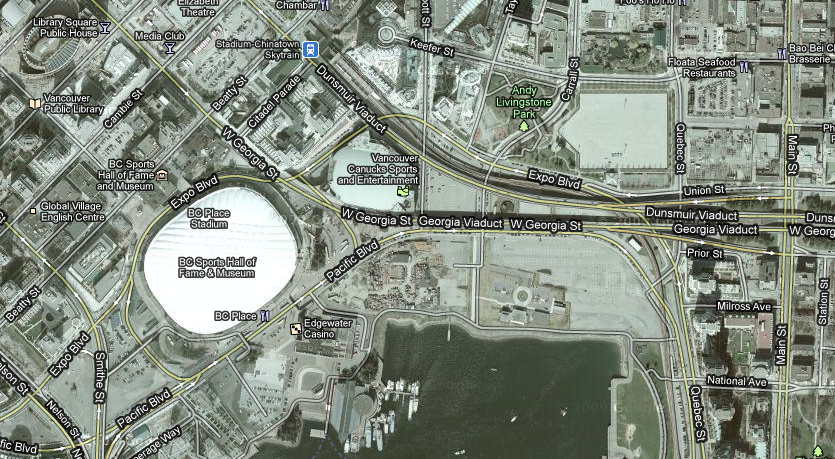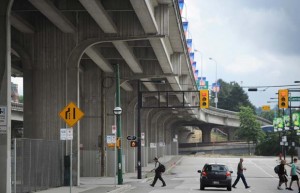Ah, the postwar era. So much blind optimism…so many planning mistakes. Back in the 1960s when highway building was de rigeur, the City of Vancouver considered an ambitious downtown highway proposal that would have destroyed many neighbourhoods in the central city, including Strathcona. The Georgia and Dunsmuir Viaducts, completed in 1971, were the only two sections of highway built, in part because they replaced an older viaduct that needed major repairs. Thanks to the mobilization of the Strathcona community, a series of successful protests prevented the rest of the proposed highways from being built. The decision was a defining moment in Vancouver’s history and left the city with a remarkably intact downtown, although the ethnically diverse Hogan’s Alley neighbourhood was lost to the Georgia Viaduct.
During last year’s Winter Olympics, city planners decided to close the viaducts, along with several major streets downtown, for safety reasons. TransLink and municipal governments actively promoted public transit use, increased service, and encouraged walking and cycling for the Olympics’ 22-day run in February 2010. The Olympics showed City Council and local residents that traffic on the viaducts could be completely replaced by increased bus and SkyTrain service; there is now a serious proposal underway to tear down the viaducts, which many consider a physical barrier to East Vancouver.

Vancouver Director of Planning Brent Toderian and city engineer Jerry Dobrovolny recently released a report stating that the number of heavy trucks using the viaducts is now half of what it was in 1996. In the past decade, planners have also introduced key initiatives encouraging trips made downtown by cycling, walking and transit, and discouraging driving trips. The viaducts are now responsible for about 20 percent of trips into the downtown peninsula, but Toderian says this percentage will decrease even more as more people switch to the sustainable modes. Toderian and Dobrovolny are requesting that City Council continue analysis, beginning with public consultations in 2012, and including an Eastern Core Strategy with detailed land use and transportation options for the viaducts, recommendations on planning principles and policy directions. What a fantastic, and long-lasting, insight from the Olympics!
Many other cities have removed freeways in recent years, as I wrote in an earlier post. New York City agencies are currently considering tearing down the Sheridan Expressway, a 1.25-mile structure that is considered a barrier to the Bronx River. The Sheridan carries about 35,000 vehicles per day. It took 60 years, but post-war innovations to planning problems are finally giving way to new–or should I say, old–solutions.

Sounds like Concord Pacific is whispering in the ears of those at city hall.. they have the most to gain from the destruction of a trade route in to Vancouver. Mark these words: The viaducts will disappear and no solid alternative will come up, other than to choke another of the city’s other roads (most likely designating the downtown eastside routes as truck routes. They don’t care anyway, they’re poor!) Commercial traffic can’t be removed if you remove the roads – only displaced.